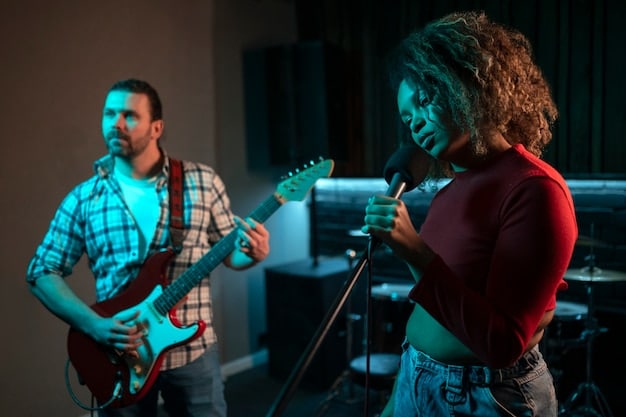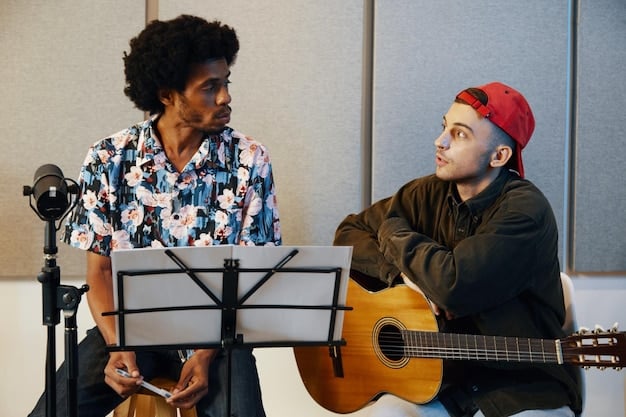Power of Collaboration: Boost Underground Artists Through Joint Projects

Collaboration among underground artists is a potent strategy to amplify their reach, consolidate resources, and foster innovative creative outputs, ultimately propelling their careers beyond niche boundaries and into broader recognition.
In the vibrant, often challenging world of independent music, standing out can feel like an uphill battle. Yet, there’s a powerful, often underutilized strategy that can dramatically expand an artist’s audience and creative horizons: The Power of Collaboration: How Underground Artists Can Expand Their Reach Through Joint Projects. Far from diluting individual identity, joint ventures can unlock new avenues for exposure, foster innovative sounds, and build a stronger, more connected artistic community.
The Strategic Imperative of Collaboration in Underground Music
The landscape of underground music is characterized by its independence, innovation, and often, its resourcefulness. However, operating outside mainstream structures often means limited marketing budgets and a smaller, albeit dedicated, audience base. This is precisely where collaboration shifts from a creative whim to a strategic imperative. By joining forces, artists can pool their individual fanbases, effectively doubling or even tripling their potential reach with a single project.
Beyond audience expansion, collaborative efforts introduce artists to diverse creative processes and genre fusions they might not explore otherwise. A rapper collaborating with an indie rock band, or a DJ working with a classical cellist, can birth entirely new sounds that captivate listeners from multiple musical spheres. This cross-pollination not only enriches the artistic output but also makes the music more appealing to a broader demographic, breaking down traditional genre barriers.
Leveraging Shared Resources and Skills
One of the most immediate and practical benefits of collaboration for underground artists is the sharing of resources. Individual artists often face financial constraints, limiting access to professional recording studios, mixing engineers, or marketing tools. When artists collaborate, these burdens are shared, making higher quality productions more attainable.
- Studio Time & Production: Shared costs for studio bookings, professional mixing, and mastering can elevate the sound quality of joint projects significantly.
- Marketing & Promotion: Instead of one artist promoting a track, multiple artists amplify the message across their respective social media channels, email lists, and personal networks.
- Skill Exchange: A songwriter might partner with a producer skilled in sound design, or a vocalist with a visual artist for a compelling music video, enhancing the overall project value.
This resource-sharing model creates a synergistic effect, where the combined efforts yield results greater than the sum of individual contributions. It democratizes access to resources that would otherwise be out of reach for a single underground artist, fostering a more equitable and productive creative environment.
Furthermore, the exchange of skills and knowledge during a collaborative project can be invaluable. Artists learn from each other’s unique approaches to songwriting, performance, and even the business aspects of music. This continuous learning enhances individual capabilities, making each artist more formidable in their subsequent solo endeavors.
In essence, strategic collaboration transforms the limitations of individual underground artistry into opportunities for collective strength and broader appeal. It’s about building bridges, not just between artists, but also between their respective fan communities, laying the groundwork for sustainable growth.
Diversifying Sound and Audience Through Creative Synergy
The allure of the underground scene often lies in its unfiltered authenticity and genre-bending experimentation. However, within these seemingly boundless creative spaces, artists can sometimes find themselves confined by their established stylistic habits or the expectations of their existing fanbase. Collaboration offers a vital key to unlocking new creative dimensions, allowing artists to transcend their comfort zones and explore uncharted musical territories.
When artists from different backgrounds converge, their unique musical vocabularies blend to form novel sonic landscapes. Imagine a folk singer-songwriter integrating elements of electronic music, or a metal band featuring a spoken-word poet. These unlikely pairings often result in truly groundbreaking and memorable tracks that defy easy categorization, attracting listeners who might otherwise overlook one of the individual artists.
Breaking Down Genre Barriers
The music industry increasingly values genre fluidity, and collaborative projects are prime vehicles for achieving this. By intentionally working with artists from disparate genres, underground musicians can organically introduce their sound to new demographics. This isn’t about abandoning one’s core identity, but rather about demonstrating versatility and an open-minded approach to artistry.
- Cross-Genre Appeal: A hip-hop artist collaborating on a track with an indie-pop vocalist can appeal to both hip-hop and indie fans.
- Expanded Playlists: Music that defies easy classification is more likely to be featured on diverse curated playlists, increasing visibility across multiple platforms.
- Broader Media Coverage: Unique collaborations often garner more attention from music blogs and journalists who are always seeking fresh, innovative stories.
The beauty of such synergy lies in its authenticity. These aren’t manufactured sounds but genuine creative collisions, driven by mutual respect and a desire to experiment. This authenticity resonates strongly with listeners, particularly within the underground community, who value originality above all else.
Furthermore, creative synergy extends beyond just the audio. Collaborative music videos, album art, and live performances can also be vehicles for artistic fusion, creating a holistic experience that is more compelling than what individual artists might produce. This comprehensive approach to collaboration amplifies the project’s impact, making it more memorable and shareable.
Ultimately, diversifying sound through collaboration isn’t just a creative exercise; it’s a strategic move that fundamentally alters an artist’s trajectory. It allows underground musicians to break free from stylistic pigeonholes, attract a wider audience, and solidify their reputation as innovative and adaptable forces within the music scene.
Navigating the Collaboration Process: Best Practices for Success
While the benefits of collaboration are clear, the process itself requires careful planning and communication to ensure a successful outcome. From initial concept to final release, a structured approach can minimize potential pitfalls and maximize creative potential. It begins with identifying the right partner, one whose artistic vision aligns with yours, but whose specific skills or audience complements your own.
The foundation of any successful joint project lies in clear and open communication. Before any notes are played or lyrics are written, artists should discuss their expectations, roles, and creative boundaries. What is each artist hoping to achieve? What level of commitment is required? Addressing these questions upfront can prevent misunderstandings later on.

Establishing Clear Roles and Expectations
Defining roles is crucial, especially when artists come from different musical backgrounds or have varying levels of experience. While some projects might thrive on fluid roles, others benefit from defined responsibilities. This ensures efficiency and accountability, preventing one artist from feeling overburdened or undervalued.
- Creative Roles: Who handles songwriting, production, mixing, and mastering?
- Promotional Roles: How will the project be marketed? Who is responsible for social media, press outreach, and distribution?
- Financial Responsibilities: How will expenses be divided, and how will any potential income be shared?
Beyond roles, setting clear expectations for deadlines, creative direction, and even the “sound” of the project is vital. A shared mood board, reference tracks, or even just a detailed conversation about desired outcomes can align creative visions from the start. This proactive approach minimizes the need for extensive revisions and ensures a smoother production process.
Another best practice involves legal considerations. While it might seem overly formal for underground artists, having a simple collaboration agreement in place—even if it’s just a written understanding—can safeguard everyone’s interests. This agreement should cover intellectual property rights, revenue sharing, and clear procedures for conflict resolution.
Finally, maintaining flexibility and a positive attitude throughout the process is paramount. Creative differences are bound to arise, but approaching them with an open mind and a willingness to compromise can turn potential obstacles into opportunities for innovation. A successful collaboration isn’t just about the final product; it’s also about nurturing a respectful and productive working relationship that could lead to future projects.
Case Studies: Inspiring Collaborative Successes in the Underground
Examining real-world examples of successful collaborations within the underground music scene provides tangible proof of its transformative power. These instances often showcase how unconventional pairings led to significant breakthroughs, proving that innovation and expanded reach are well within the grasp of independent artists. From unexpected genre fusions to artists pooling their unique fanbases, these narratives offer valuable lessons.
One notable example is the collaboration between independent electronic producer, Flying Lotus, and acclaimed jazz saxophonist, Kamasi Washington. While both artists had established followings in their respective niches, their joint projects and appearances blurred lines, introducing jazz enthusiasts to experimental electronic soundscapes and vice versa. This wasn’t merely a feature; it was an artistic dialogue that showcased the fluidity of genre and expanded the audience for both. Their work together became a benchmark for how seemingly disparate sounds could coalesce into something fresh and compelling, drawing attention from mainstream media outlets typically reserved for pop artists.
Lessons from Successful Pairings
Another compelling case involves a collective rather than a duo: the “supergroup” formations that emerge periodically from various scenes. Consider the various hip-hop collectives like Griselda, where individual artists like Westside Gunn, Conway the Machine, and Benny the Butcher maintain solo careers but frequently collaborate on projects. Their joint efforts amplify their individual voices, create a distinct shared identity, and allow them to dominate the underground hip-hop conversation with a unified, yet diverse, front. This model demonstrates how consistent internal collaboration can build a formidable brand that transcends individual popularity.
- Shared Brand Building: Collectives build a stronger brand collectively, resonating more powerfully than individual efforts.
- Cross-Promotion: Each artist’s fanbase becomes a promotional channel for the entire group and its members.
- Creative Synergy: The constant exchange of ideas within a collective fosters a highly fertile ground for innovation.
A more grassroots success story could be found in local music scenes, where artists from different bands often form side projects or one-off collaborations. For example, a lead singer from an indie rock band might lend vocals to a techno producer’s track, performing at local club nights. While less about global reach, these micro-collaborations strengthen local communities, cross-pollinate local fanbases, and often act as incubators for future full-scale projects, laying the groundwork for broader recognition.
These diverse examples underscore a central theme: successful collaborations are often born from a genuine artistic connection and a willingness to transcend comfort zones. They demonstrate that the “underground” is not a limitation, but a fertile ground for experimentation, where artists, by working together, can collectively push boundaries and carve out significant niches in the broader music landscape.
Overcoming Challenges and Fostering Lasting Partnerships
While the rewards of collaboration are substantial, the path is not always smooth. Underground artists, like any creative professionals, will encounter challenges ranging from creative differences to logistical hurdles and even issues of fair compensation. Recognizing these potential pitfalls upfront and developing strategies to address them is crucial for fostering not just successful single projects, but also lasting, productive partnerships.
Creative disagreements are perhaps the most common challenge. When two or more artistic visions meet, friction can arise. The key here is to view these differences not as roadblocks, but as opportunities for deeper exploration and negotiation. Establishing a process for respectful critique and compromise, perhaps by designating a project lead or agreeing to a neutral third-party arbiter for significant impasses, can prevent projects from derailing. Emphasizing the shared goal of creating something impactful often helps artists transcend individual ego.
Effective Conflict Resolution and Mutual Respect
Beyond creative clashes, logistical challenges can be considerable for independent artists, who often juggle multiple responsibilities. Coordinating schedules, sharing files across different time zones, and managing production timelines all require diligent organization. Utilizing collaborative tools and platforms, and having a dedicated individual (or rotating responsibility) to manage project flow, can streamline these processes. Regular check-ins and updates ensure everyone remains on the same page.
- Open Dialogue: Encourage direct, honest communication about concerns and expectations from all collaborators.
- Pre-Agreed Protocols: Establish clear guidelines for decision making, especially on creative or financial matters.
- Focus on the Art: Remind yourselves of the shared artistic vision that brought you together when challenges arise.
Fair compensation and intellectual property are other critical areas. Even if a project is initially non-monetary, discussions about how future revenues (streaming, syncs, merchandise) will be split should occur early. Formalizing these agreements, even minimally, protects all parties. Similarly, clearly defining who owns what intellectual property ensures that all contributions are acknowledged and respected, preventing future disputes over rights and credits.
Building lasting partnerships extends beyond addressing immediate project challenges. It involves cultivating a genuine appreciation for each other’s artistry and a willingness to support one another’s individual endeavors. Attending each other’s shows, sharing their solo work, and offering advice demonstrates a commitment that transcends a single joint project. This kind of consistent mutual support builds trust and a network of reliable collaborators.
By proactively addressing challenges with clear communication, respect, and a shared commitment to the art, underground artists can transform potential obstacles into strengthening factors for their collaborations, paving the way for a series of impactful and rewarding joint projects that elevate their collective and individual careers.
Strategic Distribution and Promotion of Collaborative Works
Creating compelling collaborative music is only half the battle; effectively distributing and promoting it is equally crucial for expanding reach. For underground artists, who often lack the marketing machinery of major labels, a well-thought-out strategy for getting their collaborative projects heard is paramount. This involves leveraging digital platforms, engaging with media, and tapping into combined networks.
The first step is a unified distribution plan. All collaborating artists should agree on a primary distribution platform (e.g., DistroKid, TuneCore) to ensure consistency across all streaming services and digital storefronts. This avoids fragmentation and ensures that all streams and downloads contribute to a single, trackable project. Metadata, including clear artist credits for all collaborators, must be meticulously accurate for proper attribution and discoverability.
Maximizing Digital Reach and Media Attention
Social media is an obvious, yet often underutilized, tool for collaborative promotion. Instead of individual artists posting about the project on their own feeds, develop a coordinated social media campaign. This could involve joint live streams, shared behind-the-scenes content, or even running collaborative contests. The key is to leverage the combined follower counts of all artists to create a significantly larger echo chamber for the release.
- Joint Social Media Campaigns: Coordinate release dates and content drops across all artists’ platforms for maximum impact.
- Targeted Outreach: Identify music blogs, podcasts, and online radio stations that cater to the genres of all collaborating artists, dramatically widening the scope of potential media coverage.
- Engage Influencers: Reach out to micro-influencers or curators within both artists’ musical niches who might be interested in featuring the unique collaboration.
Furthermore, pursuing media coverage requires a strategic approach. Craft a compelling press release that highlights the unique story behind the collaboration, the fusion of styles, and the individual achievements of each artist. Target music journalists, editors, and playlist curators who cover either of the artists’ individual styles or specialize in genre-bending music. A unique narrative significantly increases the likelihood of being featured.
Live performances, whether virtual or in-person, also provide powerful promotional opportunities. Joint shows or guest appearances at each other’s concerts can generate buzz and introduce fans to new sounds in an immersive setting. Consider creating unique merchandise to accompany the release, offering fans a tangible piece of the collaborative project and an additional revenue stream.
Ultimately, a successful strategic distribution and promotion plan for collaborative works is about synergy. It’s about more than just combining marketing efforts; it’s about amplifying a shared narrative and a unique artistic offering to an audience that is inherently larger than what any single underground artist could reach alone. This collective approach transforms limited individual resources into a powerful, far-reaching promotional machine, solidifying the project’s place in the broader musical consciousness.
Building Community and Support Systems Through Collaboration
Beyond the immediate creative and promotional benefits, collaboration serves a deeper, perhaps more profound, purpose for underground artists: it fosters a sense of community and builds crucial support systems. The independent music sphere can often feel isolating, with artists navigating challenges largely on their own. Joint projects, however, create bonds, amplify collective voices, and establish powerful networks that can sustain careers long-term.
When artists collaborate, they’re not just creating music; they’re forging relationships. These relationships can evolve into mentorships, peer support groups, and lasting friendships that provide invaluable emotional and practical assistance. Sharing experiences, celebrating successes, and empathizing with challenges creates a stronger, more resilient artistic community. This network becomes a vital resource for sharing opportunities, offering feedback, and navigating the complexities of the music industry.
Networking and Shared Experiences
The act of working together on a project naturally expands an artist’s professional network. Each collaborator brings their own connections—producers, engineers, photographers, videographers, booking agents, and other musicians. This organic expansion of contacts can open doors to future opportunities that would be inaccessible otherwise. A shared project acts as a reputable reference, showcasing an artist’s collaborative spirit and professional acumen to potential new partners.
- Expanded Professional Network: Gain access to new producers, engineers, venues, and media contacts through your collaborators.
- Mentorship Opportunities: Learn from more experienced collaborators or mentor emerging artists, fostering a culture of shared growth.
- Emotional Support: Overcome creative blocks or industry frustrations with a network of peers who understand your journey.
Furthermore, collaborative efforts can lead to the formation of artist collectives or movements. These groups can advocate for their members, organize community events, and create a strong, unified presence that commands more attention than disconnected individual artists. Think of how certain localized scenes gain national or international recognition due to the collective output and mutual support of their artists. This communal approach elevates everyone involved, creating a rising tide that lifts all boats.
Finally, the very act of mutual support inherent in collaboration bolsters confidence and reduces the feelings of isolation common in independent artistry. Knowing there are peers to bounce ideas off, seek advice from, or simply share the journey with, can be incredibly empowering. This shared experience cultivates a sense of belonging and purpose, reinforcing the idea that the underground music scene is a vibrant ecosystem where artists thrive together, rather than compete in isolation.
Ultimately, collaborations are investments in community. They create a stronger ecosystem for underground music, built on shared creativity, mutual respect, and collective ambition. This supportive environment not only benefits individual artists by expanding their reach and opportunities but also enriches the entire independent music landscape.
| Key Benefit | Brief Description |
|---|---|
| 📈 Audience Expansion | Combine fanbases for significantly broader reach and new listener acquisition. |
| 🎨 Creative Innovation | Fuse diverse styles to create fresh sounds and explore untapped genres. |
| 💰 Shared Resources | Pool funds and skills for high-quality production, mixing, and marketing. |
| 🤝 Community Building | Forge lasting relationships, peer support, and a stronger artistic network. |
Frequently Asked Questions About Artist Collaboration
▼
Collaboration is crucial for underground artists as it provides a direct path to audience expansion, resource sharing, and creative diversification, aspects often limited when operating independently. It enables them to reach beyond niche audiences, access better production quality, and elevate their artistic profile in a competitive landscape.
▼
Finding the right collaborator involves identifying artists whose musical style complements yours and whose artistic vision aligns with your own. Attend local shows, network online, explore diverse music platforms, and engage with musicians whose work you admire. Look for artists offering skills or a fanbase that can genuinely enhance your project.
▼
Essential steps include establishing clear communication, defining roles and responsibilities upfront, discussing financial expectations and intellectual property, and setting realistic deadlines. Maintaining flexibility and mutual respect throughout the creative process is also paramount for a thriving partnership and a successful outcome.
▼
Collaborations can effectively break creative blocks by introducing new perspectives, ideas, and musical approaches. Working with another artist often sparks fresh inspiration, challenges existing habits, and pushes boundaries, leading to unexpected and innovative creative breakthroughs that might not occur in isolation.
▼
While often informal, underground artists should consider a simple written agreement outlining intellectual property rights, revenue splits, credit allocation, and conflict resolution procedures. This doesn’t need to be legally complex but ensures all parties are clear on their roles and benefits, safeguarding the partnership and project.
Conclusion
In the evolving tapestry of underground music, the path to broader recognition is rarely linear or solitary. The evidence clearly points to a powerful catalyst: collaboration. From amplifying reach by combining fanbases and sharing crucial resources to igniting creative sparks that transcend traditional genre boundaries, joint projects offer a multifaceted approach to growth and innovation. They transform the challenges of independent artistry into opportunities for collective strength, fostering a vibrant, supportive ecosystem where artists don’t just survive, but thrive together. By embracing the power of working in concert, underground artists can craft compelling narratives, expand their sonic footprint, and build lasting legacies that resonate far beyond the niches they began in.





